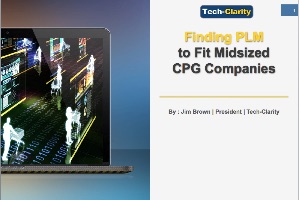 Finding PLM to Fit Midsized CPG Companies explains how smaller Consumer Packaged Goods (CPG) companies find themselves stuck between full-featured Product Lifecycle Management (PLM) systems that feel out of reach and less capable solutions including cloud-based file sharing or very basic data management applications. They know they can’t afford the errors and inefficiency inherent to informal data and process management, but can’t afford a large time, resource, and financial investment to fix their problems. Unfortunately simple solutions, while very attractive, fall short of their real needs, don’t help them improve their business the way they want to, and don’t leave them room to grow in the future. They need to find the “sweet spot” of a solution that helps them get started quickly with the basics of controlling, managing, and sharing product data but provides the features they need to be successful now and into the future.
Finding PLM to Fit Midsized CPG Companies explains how smaller Consumer Packaged Goods (CPG) companies find themselves stuck between full-featured Product Lifecycle Management (PLM) systems that feel out of reach and less capable solutions including cloud-based file sharing or very basic data management applications. They know they can’t afford the errors and inefficiency inherent to informal data and process management, but can’t afford a large time, resource, and financial investment to fix their problems. Unfortunately simple solutions, while very attractive, fall short of their real needs, don’t help them improve their business the way they want to, and don’t leave them room to grow in the future. They need to find the “sweet spot” of a solution that helps them get started quickly with the basics of controlling, managing, and sharing product data but provides the features they need to be successful now and into the future.
Please enjoy the summary below.
For the full eBook, please visit our sponsor Dassault Systèmes and scroll down to the E-Books and Infographics section (free of charge, registration required).
Midsize Manufacturers Stuck in Between
Midsize consumer packaged goods (CPG) companies, their suppliers, and their partners face continuous pressure in today’s competitive, global marketplace. They have to adopt strategies combining product innovation and agility to survive. But developing and launching successful products today is complex. It requires deep customer insights, technical knowhow, and collaboration. Midsize companies have to overcome this complexity to compete with larger competitors. They have to connect closely with consumers and introduce new products quickly and efficiently to meet their needs.
Product Lifecycle Management (PLM) software can help. It drives better product development performance by managing product-related data, processes, and projects. While smaller companies may be able to control, access, and share product data with relatively simple content sharing tools, larger companies rely on full-featured PLM to help automate processes and share data across global supply chains.
Midsize companies may find themselves in-between because:
- Product and organizational complexity drive them beyond basic PDM capabilities
- A full-featured PLM implementation may feel out of reach
Midsize manufacturers need to choose a system that quickly delivers the core capabilities they need to streamline product development but also gives them room to grow value over time. So what’s the right size PLM to fit a midsized manufacturer? Let’s take a look.
Get Started with the Right PLM Solution
Core PLM can quickly add value to midsized companies by helping them combat complexity, improve productivity, and stay closer to customers. Recognize the potential value of a fully featured PLM with all of the bells and whistles, but be honest with yourself about whether your company can afford the time and effort to get there (at least right away).
 Don’t take on too much. Start with the basics and get value quickly, but recognize the shortcomings of simple file sharing solutions that fall short for the complex products and product development environments common to midsize manufacturers. Look for a solution that allows you to design in the context of your products in real time, but also in the context of processes and product development projects. In addition, look for PLM that incorporates automation including integrated design tools and automated project updates to keep product developers focused on innovation instead of managing files.
Don’t take on too much. Start with the basics and get value quickly, but recognize the shortcomings of simple file sharing solutions that fall short for the complex products and product development environments common to midsize manufacturers. Look for a solution that allows you to design in the context of your products in real time, but also in the context of processes and product development projects. In addition, look for PLM that incorporates automation including integrated design tools and automated project updates to keep product developers focused on innovation instead of managing files.
Finally, make sure to leave your company room to grow as your business dictates, using the initial implementation as a foundation for greater improvements. Find a solution that offers more advanced capabilities, such as simulation, that your company can leverage when they are ready.
*This summary is an abbreviated version of the report and does not contain the full content. A link to download the full report is available above. If you have difficulty obtaining a copy of the report, please contact us using the “Contact” link below.

